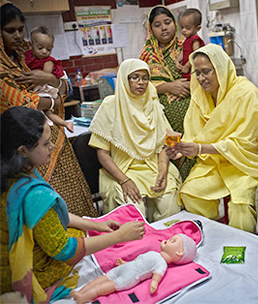 The Phase Change Matters e-mail newsletter is a weekly summary of the latest news and research on phase change materials and thermal energy storage. To subscribe, visit www.puretemp.com/subscribe. For more frequent updates, follow @puretemp on Twitter or visit the Phase Change Matters blog, www.puretemp.com/pcmatters.
The Phase Change Matters e-mail newsletter is a weekly summary of the latest news and research on phase change materials and thermal energy storage. To subscribe, visit www.puretemp.com/subscribe. For more frequent updates, follow @puretemp on Twitter or visit the Phase Change Matters blog, www.puretemp.com/pcmatters.
BUILDINGS | HVAC
PCM building technology guidelines to be published this fall
The Association of German Engineers committee responsible for developing guidelines on PCM storage systems in building technology (VDI 2164, PCM-Energiespeichersysteme in der Gebäudetechnik) is expected to complete its work this month, with publication in the fall.
The guidelines define the fundamentals of using latent heat storage materials in heating, cooling, ventilation and thermal energy storage systems. The guidelines also define the basics of PCM storage systems and provide planning and calculation methods for proper design and their performance parameters.
The guidelines, which are not legally binding, can be seen as “reassurance for experts that they are in line with the recognized state of the art technology,” according to Stefan Thomann, managing director of the RAL Quality Association PCM, a European-based organization established in 2004 to develop standards for the phase change material industry.
 The Association of German Engineers (Verein Deutscher Ingenieure, or VDI) and Deutscher Industrieverlag will host their first joint congress for technical building equipment in Baden-Baden, Germany, Nov. 29-30. Dr. Bernd Boiting, right, president of the PCM quality association and chairman of the VDI 2164 committee, will give a lecture about PCM storage systems and the new guidelines.
The Association of German Engineers (Verein Deutscher Ingenieure, or VDI) and Deutscher Industrieverlag will host their first joint congress for technical building equipment in Baden-Baden, Germany, Nov. 29-30. Dr. Bernd Boiting, right, president of the PCM quality association and chairman of the VDI 2164 committee, will give a lecture about PCM storage systems and the new guidelines.
The congress is expected to attract 500 or more participants. The complete agenda, along with contact information, is likely to be available in June.
AWARDS
A winning idea: PCM-powered rental boxes for India’s food supply chain
Refrigerated produce trucks are common in developed countries. Not so in India, where about 40 percent of fresh fruit and vegetables spoils before reaching consumers. A team of MIT and Harvard University students is developing a system designed to reduce that waste and lower distribution costs. Their idea won the first MIT Food and Agribusiness Innovation Prize awarded last week in Cambridge, Mass.
 At the heart of the system are rental boxes packed with phase change material. The insulated, collapsible boxes will be sized to fit on traditional dry trucks, which are far cheaper to own or rent than refrigerated trucks. The boxes are kept cold in refrigerated warehouses until they are filled with produce. Each box is equipped with a device to track location, temperature, humidity and payment information in real time.
At the heart of the system are rental boxes packed with phase change material. The insulated, collapsible boxes will be sized to fit on traditional dry trucks, which are far cheaper to own or rent than refrigerated trucks. The boxes are kept cold in refrigerated warehouses until they are filled with produce. Each box is equipped with a device to track location, temperature, humidity and payment information in real time.
“We’re thrilled that we won the inaugural MIT Food and Agribusiness Innovation Prize,” said Naren Tallapragada, right, a member of the winning gomango team. “It was an honor and a privilege to share the stage with other talented teams with a passion for food, agriculture and sustainability. We’d like to thank the contest team, judges, sponsors and mentors for all of their support — and, of course, for recognizing that phase change materials could help the developing world transport its perishable goods affordably.”
Tallapragada, who is pursuing a Ph.D. in systems biology at Harvard, said the team continues to refine its technology and strategy. Gomango plans to use the $12,000 award to develop commercial prototypes for a pilot project in India.
A team of MIT students, Safi Organics, won the $8,000 second-place prize for its work on a low-cost organic fertilizer. A team of MIT and Harvard students, Ricult, won a $5,000 third-place prize for a cellphone-based system that connects small farmers in developing countries to “buyers, farm input sellers, banks, logistics and critical farming information.”
PATENTS
Improved phase change compositions
U.S. patent application 20160102232 (applicant Sunamp Ltd., Edinburgh, Scotland):
“There are herein described phase change materials containing sodium acetate trihydrate having improved homogeneity, a process for the preparation of said materials, and their utility in phase change systems. More particularly, the present invention relates to the use of phase change compositions comprising sodium acetate trihydrate, at least one alkali soluble polymer for inhibition of sodium acetate anhydrous crystal formation in sodium acetate trihydrate containing phase change materials, and at least one sodium acetate trihydrate nucleation promoter, and, if a lower phase change temperature is required, at least one melting point depressing agent.”
Heating appliance comprising a phase change material
U.S. patent application 20160123627 (applicant Societe Muller & Cie, Paris):
“A heating appliance includes a frame and a heating element. The frame has a casing and a rear face demarcating an internal volume of the frame. The rear face is configured to be secured to a wall that is substantially vertical. The heating element is placed in the internal volume of the frame. The casing of the heating appliance includes a phase-change material.”
Latent heat storage module and latent heat storage apparatus
U.S. patent application 20160123680 (applicant Hyundai Motor Co., Seoul, South Korea):
“A latent heat storage module includes a plurality of film packs configured to accommodate a phase change material configured to use phase change latent heat as a heat medium of room temperature (0.degree. C. or more). A guide is configured to fix the plurality of film packs.”
IN BRIEF
 • U.S. and Bangladeshi scientists have developed a low-cost “thermal blanket” designed to save the lives of premature babies in developing countries. The device contains sodium acetate, a phase change material that releases latent heat as it changes from liquid to solid form. “One of our contributions to product development is the use of semi-solid hydrogenated oil as a buffer to absorb excess heat and extend the duration of optimal heat maintenance in the blanket,” says M.A. Quaiyum, co-principal investigator and scientist at the International Centre for Diarrhoeal Disease and Research in Bangladesh.
• U.S. and Bangladeshi scientists have developed a low-cost “thermal blanket” designed to save the lives of premature babies in developing countries. The device contains sodium acetate, a phase change material that releases latent heat as it changes from liquid to solid form. “One of our contributions to product development is the use of semi-solid hydrogenated oil as a buffer to absorb excess heat and extend the duration of optimal heat maintenance in the blanket,” says M.A. Quaiyum, co-principal investigator and scientist at the International Centre for Diarrhoeal Disease and Research in Bangladesh.
• California-based SolarReserve and Shenhua Group of China have agreed to work together to develop 1,000 megawatts of advanced solar energy projects in China. SolarReserve technology uses mirrors to focus sunlight to directly heat molten salt and then store it so electricity can be produced around the clock.
• A new method to analyze and define chemical risk will make it easier and cheaper to manage potential risks, according to new research published in the journal Risk Analysis.
• Paul Valento, CALMAC‘s vice president of sales and marketing, was among the speakers at this week’s High Performance Buildings & Workplaces show in Austin, Texas. The topic: “Using Ice Storage to Enhance Solar Assets & Reduce Peak Demand.”
• China has strengthened cold chain regulations in the wake of a scandal involving the illegal sale of expired and improperly handled vaccines. County health officials are now required to get vaccines directly from manufacturers before sending them to hospitals, instead of going through wholesalers. Hospitals, clinics and government authorities must also keep better records of purchases and inventory, with regular monitoring of vaccine temperatures.
• Pelican BioThermal, the temperature-controlled packaging specialist, recently announced partnerships with BioThermal Solutions of Chile and NatBio of Brazil.
• New from QYResearch: “Market Research on Phase Change Thermal Interface Material (PCTIM) Industry in Europe 2016“
• A model of a NASA spacesuit made with phase change material was displayed at the Outlast Technologies booth at OT World 2016, the world’s largest prosthetics conference, in Leipzig, Germany, this week.
RESEARCH ROUNDUP
For our full list of recent academic research, see puretemp.com/academic. Here are highlights from the past week:
From RSC Advances:• From rice husk to high-performance shape-stabilized phase change materials for thermal energy storage
• Porous ceramic stabilized phase change materials for thermal energy storage
From Energy Conversion and Management:
• Experimental assessment on the use of phase change materials (PCMs)-bricks in the exterior wall of a full-scale room
• Parameter design for a phase change material board installed on the inner surface of building exterior envelopes for cooling in China
From Energy and Buildings:
• Parametric analysis for performance enhancement of phase change materials in naturally ventilated buildings
From Energy Conversion and Management:
• Characterization of thermophysical properties of phase change materials for non-membrane based indirect solar desalination application
From Solar Energy Materials and Solar Cells:
• The sodium nitrate–urea binary mixture as a phase change material for medium temperature thermal energy storage. Part I: Determination of the phase diagram and main thermal properties
From Energy:
• Thermophysical properties and thermal characteristics of phase change emulsion for thermal energy storage media
From Renewable Energy:
• Design and feasibility of high temperature shell and tube latent heat thermal energy storage system for solar thermal power plants
From Applied Polymer Science:
• Photocrosslinked biobased phase change material for thermal energy storage
NETWORKING
Connect with PCM experts and industry leaders on LinkedIn
More than 700 of your peers have joined a LinkedIn group devoted to the discussion of phase change material and thermal energy storage. The Phase Change Matters group is an interactive complement to the award-winning blog and newsletter of the same name.
You are invited to join the group and connect with PCM and TES experts from around the world. New members this week include Eva Mechó Laussac, head of cold chain packaging at Basalta Inc., Belgium; Inés Fernández, associate professor at the University of Barcelona, Spain; Mingyu Wang lead technologist at Delphi Automotive, Lockport, N.Y.; and Emily Feng, research assistant at Rensselaer Polytechnic Institute, Troy, N.Y.